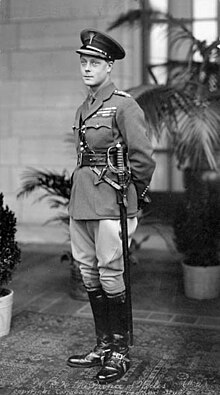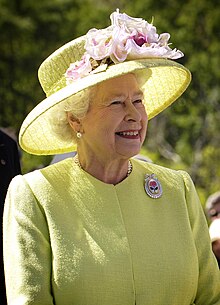A History of the British Monarchy/Windsor Rulers
The House of Windsor was created in 1917 when George V relinquished all German titles from the British Royal Family and this included changing the families last name from Wettin and house name from Saxe-Coburg and Gotha to Windsor, after the Monarch's ancestral home, Windsor Castle. The Monarchy came from the German house of Saxe-Coburg and Gotha. This also meant relatives that had German titles were created British Peers and relinquished all their German titles. This included the family of Queen Mary, King George's consort. Her family were descendents of Duke of Teck and now were created Marquess of Cambridge, a title recreated in the name Duke of Cambridge, used by Prince William, the son of the Prince of Wales.

George V was the first Windsor ruler. George V, the first head of the House was the King during the Great War (World War I) and the Irish Uprising. The second longest reign of the House of Windsor. In 1911 he went to India, making him the first King-Emperor to do so. When the War came, the King stayed at home uplifting the hope and spirits of the soldiers, nurses and families affected. This included around 450 visits to the Troops and 300 to various hospitals. During his reign, the Irish Free State was set up and this turned into the Irish Republic. The top 6 counties stayed a part of the United Kingdom. In 1924 George welcomed the first Labour Government. But in 1929 he asked the Government to form a Coalition which would mix all the parties due to the 1929 Crisis. In 1931 the Statute of Westminster was created making the Crown more important. This was due to no Dominion laws having to be linked to the British Parliament. But they were linked to the Crown. In 1932 he started the annual Christmas Broadcast which is a tradition continued until today. In 1935 he celebrated his Silver Jubilee by touring around Britain. It was a great celebration. The King's health declined rapidly and he died on 20 January 1936.

George was succeeded by his oldest son Edward who was proclaimed Edward VIII. George believed Edward would destroy the country in 12 months. He was proclaimed King at St James Palace on 21 January 1936. He watched the proclamation with Wallis Simpson, an American socialite who he met through Lady Furness. She had been divorced previously (twice) and Edward wanted to marry her and for her to be Queen-Consort. The news of this story was kept out of the press in the UK, but was a large story in America. Frustration grew between Edward, the Prime Minister, Stanley Baldwin and the Cabinet and the public started to worried about the Constitution Crisis. But it had hit turmoil. Wallis had left Britain for her friends Villa in Southern France. Edward on the 10th December abdicated leaving his Brother, Prince Albert, Duke of York, King. Edward left for France and had to wait for 6 months to marry due to British divorce law. Edward married Wallis on the 3rd June, 1937 at the Chateâu de Candé. No member of the Royal Family were in attendance. Edward was given the title Duke of Windsor, with Wallis as his Duchess, but not with the HRH status. This angered Edward due to Wallis deserving the style of a royal. Edward was a figure who was said to prefer Hitler and like his views. To keep him away from Europe during the War, he was given an appointment as the Governor of the Bahamas. This was an appointment he thought of as a disrespect to his HRH status. Edward after the war lived abroad and only came to London for special events such as the opening of his mothers, Mary of Teck Memorial. He died in Paris on 28 May 1972.

Prince Albert, Duke of York succeeded his brother as British Monarch on the abdication of his brother. He presented the model family during a time of despair. He was a former naval officer, who had a steady, simple life. He married Lady Elizabeth Bowes-Lyon in 1923. She was the person that kept him stable and peaceful and helped him when he came to the Throne. During World War II, he did not retreat to Windsor and stayed at Buckingham Palace to be with his people and Government. However, he retreated at night to sleep at Windsor. During the War he showed great resilience and was a sign of greatness for the people. He created a great relationship with his War-time Prime Minister Winston Churchill. In 1940 he created the George Cross and in 1942 he gave this to the nation of Malta for resisting enemy siege. On 8 May 1945, Victory in Europe was declared and the King, Queen and the 2 Princesses joined by Winston Churchill waved to their people on the balcony of Buckingham Palace. In 1947 India and Pakistan gained independence. This made an allegiance to the Crown was no longer common, but to the Crown as Head of the Commonwealth. This was the beginning of the Commonwealth. The War aged the King greatly and could not recover from a lung operation. He died on 6 February 1952 during his sleep of Lung Cancer. His daughter Princess Elizabeth. Duchess of Edinburgh was proclaimed Queen at age 25.

Elizabeth was very young when she became Queen. At the time, she was in Kenya on a Commonwealth tour. She last saw her father before she departed. Her husband told her about her father's death and they went back to London suddenly. They had to wait a day due to bad weather. They arrived in London greeted by her Prime Minister Winston Churchill and members of the Government. 16 months later she was coroneted Queen at Westminster Abbey. Her son, Prince Charles (then Duke of Cornwall) was the Heir Apparent at age 3. Elizabeth saw a lot of things change during her reign. She saw the rise of the Commonwealth Nations, which now has 54 nation members. In 1970's the saw many economic problems and the Royal family were also going in the red. The Queen was given a pay rise to £1,000,000. This made the public angry as many could not find jobs or work. In 1977 she celebrated her Silver Jubilee. This milestone was a turnaround from all the turmoil of the early seventies. In 1979 Margaret Thatcher became Britain's first Female Prime Minister and she clashed with The Queen frequently. In 1982 the Falkland Islands were invaded by the Argentine Government. The country reacted to this and won the battle. In 1992, on her 40th Jubilee, 3 of her 4 children separated and part of Windsor Castle burnt down. She opened the palaces to pay for the reconstruction and started to pay income tax. In August 1997, Diana, Princess of Wales died in a car accident in Paris and she did not react to the public's call. In this time period 1 out of 4 people wanted to abolish the monarchy. In 2002, in a space of 6 weeks the Princess Margaret (The Queen's sister) and the Queen Mother died. The 2 most closest people to her died leaving her lonely. She also celebrated her Golden Jubilee. In 2005, The Prince of Wales remarried. He married the divorced Camilla Parker-Bowles. They married in the Windsor Guildhall, with a service at Windsor Castle later. The wedding was delayed a day due to the death of Pope John Paul II. In 2012, the Queen celebrated her Diamond Jubilee. She is the second monarch to reach this, the first being Queen Victoria. The Queen was the oldest ever Monarch, dying at the age of 96 on September 8, 2022.